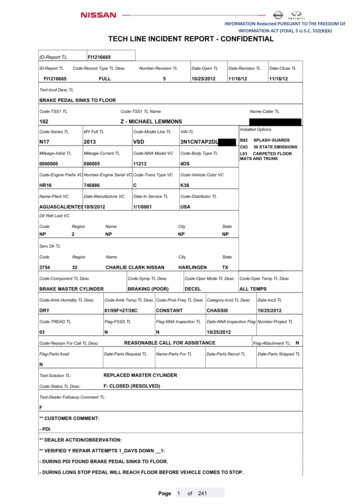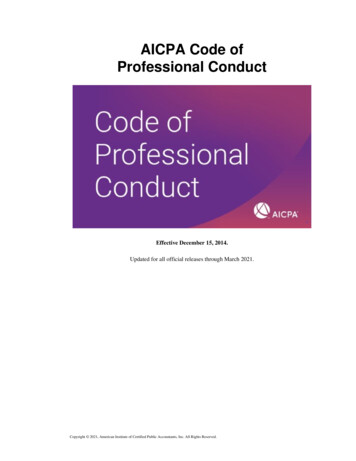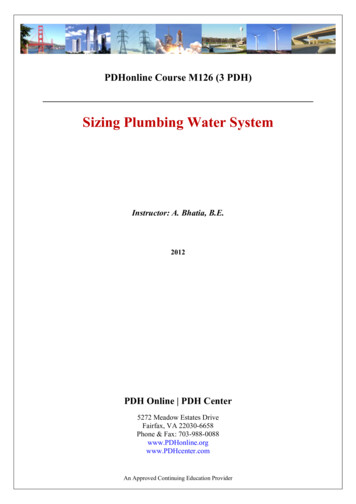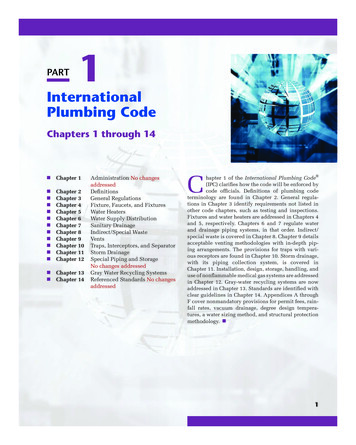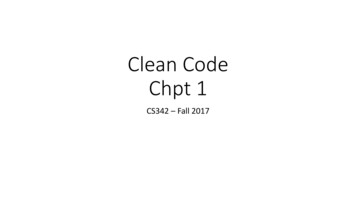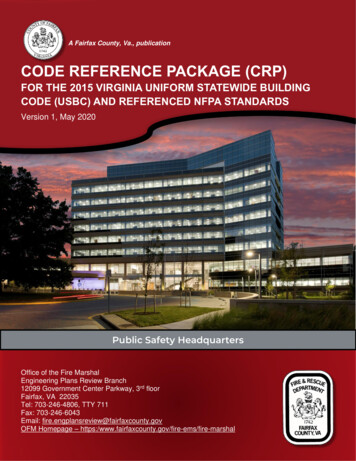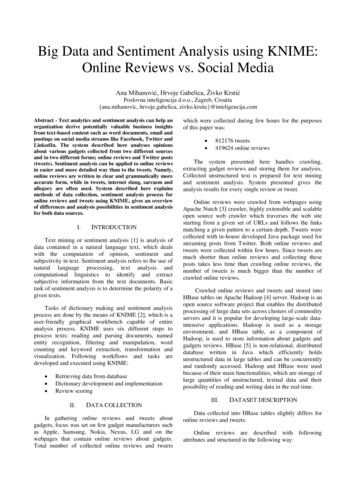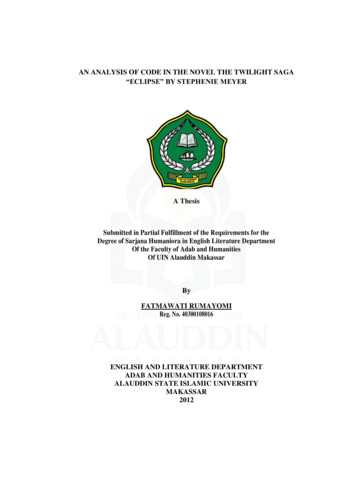
Transcription
AN ANALYSIS OF CODE IN THE NOVEL THE TWILIGHT SAGA“ECLIPSE” BY STEPHENIE MEYERA ThesisSubmitted in Partial Fulfillment of the Requirements for theDegree of Sarjana Humaniora in English Literature DepartmentOf the Faculty of Adab and HumanitiesOf UIN Alauddin MakassarByFATMAWATI RUMAYOMIReg. No. 40300108016ENGLISH AND LITERATURE DEPARTMENTADAB AND HUMANITIES FACULTYALAUDDIN STATE ISLAMIC UNIVERSITYMAKASSAR2012
PERNYATAAN KEASLIAN SKRIPSIDengan penuh kesadaran, penulis yang bertanda tangan di bawah inimenyatakan bahwa skripsi ini benar hasil karya penulis sendiri. Jika di kemudianhari terbukti merupakan duplikat, tiruan, plagiat atau disusun oleh orang lainsecara keseluruhan atau sebahagian, maka skripsi dan gelar yang diperolehkarenanya, batal demi hukum dan siap dipertanggung jawabkan.Makassar,September 2012Penulis,FATMAWATI RUMAYOMINIM40300108016
ACKNOWLEDGMENTAlhamdulillahi Rabbil „Alamin, the writer praises to the almighty ALLAHswt for His blessing and merciful so he can complete this thesis. Peace andsalutation are addressed to the beloved and chosen messenger Muhammad SAWwho has guided human beings from the darkness to the lightness, from stupid erato the clever era.The writer realizes that this thesis could not be completed without gettingassistance, guidance, understanding and encouragement from many people.Therefore, she would like to express her deepest gratitude to the following people:1. The writer‟s beloved parents, B. Tahaya and Matelda R. for their love,patience, and sincere prayers for her safety and success.2. The Rector of UIN Alauddin Makkassar, Prof. DR. H. A. Qadir Gassing HT.,M.S. who has given her a chance to study in the English and LiteratureDepartment so that she could finish her study.3. Dean of Adab and humanities Faculty, Prof. Dr. Mardan, M. Ag. and hisstaff, the Head of English and Literature Department Dr. Abd. Muin, M. Humand the Secretary of English and Literature Department Serliah Nur, S. Pd.M. Hum. M. Ed. for their support, help and encouragement.4. Prof. Dr. Mardan, M. Ag. and Syahruni Junaid, S.S., M.Pd. her first andsecond consultants who have given her fruitful comments, guidance,suggestions, corrections, and over all support since the preliminary part ofthis thesis until the end.
5. All lecturers of Adab and Humanities Faculty UIN Alauddin Makassar whohave contributed and transferred their knowledge to her to be very helpful anduseful for her.6. The writer‟s thanks are also addressed to her beloved friends in EnglishLiterature Department 2008, especially AG.1 and ECUINSA Meeting Clubwhich she shared experiences and knowledge during her study and writingthis thesis.7. The writer‟s thanks are addressed to all her brothers and sisters IMMawanand IMMawati at Students Association of Muhammadiyah board of Makassarand Gowa who have given her experiences about organization and Islamicknowledge. May ALLAH swt bless us all now and in the hereafter.8. The writer thanks are addressed to her beloved brothers and sisters Hj.Suryanti, Suryani,Nurbeda, Nurhayati, Matelda, Kurniawati Nur,Mutmainnah and Inawati and her brothers Ilham, Asis and Sriyatno who havegiven her support and their help during her study and writing this thesis.The WriterFatmawati Rumayomi
TABLE OF CONTENTTITLE PAGE .iPENGASAHAN SKRIPSI .iiHALAMAN PERNYATAAN KEASLIAN SKRIPSI .iiiPERSETUJUAN PEMBIMBING .ivAPROVAL SHEET .vACKNOWLEDGMENT .viTABLE OF CONTENTS .viiABSTRACT .viiiCHAPTER I INTRODUCTION .1A. Background .1B. Problem Statement .3C. Objective of the Research .4D. Significance of the Research .4E. Scope of the Research .4CHAPTER II REVIEW OF RELATED LITERATURE .5A. Previous Study .5B. Novel .6C. Semiotic .10D. Code .12E. Symbol .15F. Synopsis .17G. Biography .18
CHAPTER III METHODOLOGY OF RESEARCH .20A. Method of Research .20B. Source of Research.20C. Instrument of Research .20D. Procedures of Research .21E. The Technique of Data Analysis .21CHAPTER IV FINDINGS AND DISCUSSION .22A. Findings .22B. Discussion .26CHAPTER V CONCLUSION AND SUGGESTION .31A. Conclusion .31B. Suggestion .31BIBLIOGRAPHY .33
ABSTRACTName: FATMAWATI RUMAYOMIReg. Number : 40300108016Title:AN ANALYSIS OF CODE IN THE NOVEL THETWILIGHTConsultantsSAGA ECLIPSE BY STEPHENIE MEYER.: Mardan and Syahruni JunaidThis thesis is a research about an analysis of code in the novel “theTwilight Saga Eclipse by Stephenie Meyer” by using Roland Barthes theory. Theaim of the novel “the Twilight Saga Eclipse” is to represented about all of cultureor tradition that always do by human. The objectives of this research are to knowhow the culture codes are represented in the novel “the Twilight Saga Eclipse”.This research uses descriptive qualitative method. The sources of data are thenovel “the Twilight Saga Eclipse” by Stephenie Meyer which published in 2007and the books related to the topic of this research. In collecting the reasearch data,the writer used note taking as its istrument to get the data.In this novel, the writer found that there is gnomic or culture code whichrepresented in the novel of the twilight Saga Eclipse, the gnomic or culture codesare: An Ultimatum as warning, demand and command or order. La Push such ascivilization or culture, development of technology, modern society andeducational centre. Imprint like destiny, love and match. Spirit warrior such ascustom or tradition, belief and power. Vampire as Dracula, ghost, legend orfolklore. Ethics like norm, role, habit, custom, and attitude or behavior.
CHAPTER IINTRODUCTIONA. BackgroundLanguage is the most important tool of human beings. Everybody canexpress their feelings, purpose, minds and willingness through language.Therefore, with language we not only can get any information but also giveany information. As Ba‟dulu (1996:170) said that language has aninformational function in which language is used to convey information toother persons. The information that is conveyed can through some mediums.One of them is literary works where human express their feelings and ideas.As we know that literatures divided into some literary works and one of themis novel.In novel there are dialogues and actions, it becomes a way to conveyfeeling and thought that can be used to criticize everything that happens in thisworld where someone lives. Besides that, it also has certain elements thatbuild it to be interesting to read. One of characteristic features of the novel iscodes. Code is a set of convention or sub-codes currently in communicationmeaning. The most common is one‟s spoken language, but the term can alsobe used to refer to any narrative form: consider the color scheme of an image(e.g. red for danger), or the roles of a broad game. Then code meanssomething that is used to represent something else, like an idea.
Understanding of codes in a literary work, especially in novel is veryimportant to reveal the secret and significance which is contained in the novel(Manoy, 2009:1-2).According to Barthes there are five codes that can be analyzed in thenovel. These codes that observed by Barthes are: hermeneutic code (riddlecode), semic code (connotative meaning), symbolic code, proaretic code(action logic), and gnomic code (culture code) in (Barthes, 1953:55-56).1. Hermeneutic code or puzzle code is revolved on the expectation of readerto get “truth” of question that appears in the text.2. Semic code or connotative code bargain much side for the readers, so thereaders will arrange theme base on certain connotation words and phrasesthat resemble in a text.3. Symbolic code or fiction code is the process to find the certain meaningthat can identification from the biner opposition, different phoneme,although psychosexual opposition.4. The proaretic code relationship with the narrative act that can happen inthe sequent, depend on the genre of novel.5. Gnomic code or culture code according to Barthes shows that the codesare comes in the text, based on the certain things and events that cancodification by certain culture system.In the novel The Twilight Saga “Eclipse” by Stephenie Meyer, thereare some codes that will describe the meaning that is conveyed by the author.The author of this novel is Stephenie Mayer, born in Hartford, Connecticut.
She is the bestselling author of the young adult novel The Twilight Saga andits sequels. Stephenie Meyer graduated from Brigham Young University witha degree in English Literature and lives with her husband and three young sonsin Arizona (Brown, 2009:205).Eclipse is the third novel in The Twilight SagabyStephenie Meyer. Itcontinues the story of Bella Swan and her vampire love, Edward Cullen. Thenovel explores Bella's choice between her love for Edward and her friendshipwith werewolf, Jacob Black (Arimbi, 2008:269).The researcher chooses this novel to analyze the codes (The TwilightSaga “Eclipse”) are delivered by the author, because in this novel an authordescribe about some of secrets that must be known of the readers. In thisnovel, the author tries to describe about the legend of werewolf, imprint,vampire, love, nature, ethic, and friendship. All lot of they represent aboutculture, and social life in this world. Therefore to know about these points, theresearcher interested to research about them by using semiotic codes torevealed clearly the meaning of what an author express in this novel.B. Problem StatementIn analyzing The Twilight Saga “Eclipse” by Stephenie Meyer, theresearcher formulates the research questions as follows:1. What are the culture codes in The Twilight Saga “Eclipse” by StephenieMeyer?2.How are the culture codes that represented in the novel The Twilight Saga“Eclipse” by Stephenie Meyer?
C. Objective of the ResearchFor this research, the researcher wants to find out about what are theculture codes, then the researcher analysis about how the culture codesrepresented in the novel The Twilight Saga “Eclipse” by Stephenie Meyer.D. Significant of the ResearchThe study will be beneficial since it will be significant insight aboutnovel creation especially with regard to semiotic code.The following is the significant in details:1. The result of the research will enrich social horizon, which is useful for thesocial life.2. The result of the research is also useful to students who wish to observeabout codes in semiotic.3. The result of the research will make the reader knows about how thesemiotic codes are developed in the novel.E. Scope of the ResearchThe limit of this research is the researcher just analysis about culturecodes thatrepresented in the novelThe Twilight Saga “Eclipse” by StephenieMeyer.
CHAPTER IIREVIEW OF RELATED THEORYA. Previous StudyHikmawati (2005) in her thesis entitled Analysis the Kind of Symbolin Linda Pastan Poem‟s “Ethic”. She used Charles Sander Pierce‟s theory(semiotic or semiology approach) to analyze the symbol in the poem. In thisthesis, Pierce suggest that, “semiotic is the systemizing study about productionand interpretation sign. Based on the finding, she revealed in the Linda Pastanpoem used more symbols of interpretation such as description statement objectlike: icon, index and symbol.Bahri (2009) in his thesis entitled An Analysis Semiotic on Witch inthe Chronicles of Narnia. He used semiotic theory by Ferdinand De Saussureto analyze witch in novel Chronicles by Narnia. Saussure in this thesis saidthat “semiotic is the study of sign process (semiosis), or significationcommunication, sign and symbol, both individually and grouped into signsystems. It includes the study of how meaning is constructed and understood.Based on the finding, he revealed that in the novel Chronicles of Narnia used acharacteristic of witch who describe as woman, powerful, evil, authority,fierce, savage, cruel, and inadvertently.Wahyudin, (2009) in his thesis entitled The Analysis Semiotic in theAngel and Demons. He used Roland Barthes Theory (semiotic approach) toanalyze the codes in the novel Angel and demons. In this thesis Barthesdefinite semiotic is “the since of sign system”.
Based on the findings, she revealed that in the novel Angel andDemons used some semiotic codes to describe about truth, culture, and thepuzzle.Based on previous findings above the writer concluded that each ofthem use the same theory and different object. To more clearly, we see that inthe Hikmawati‟s thesis, she used Charles Sander Pierce‟s theory (semiotic orsemiology) and the object is “poem” then the findings are icon, index, andsymbol. Bahri in his thesis used Ferdinand De Saussure‟s theory (semioticapproach) to analyze the novel and her findings are: woman, powerful, evil,authority, fierce, savage, cruel, and inadvertently. The next is Wahyudin, histhesis used Roland Barthes‟ theory (semiotic communication) to analyze noveland her findings are: truth, culture, and puzzle. In the last the writer‟s thesis isusing Roland Barthes theory (semiotic communication) to analyze semioticcodes in the novel Twilight Saga “Eclipse” while this thesis only concerns onthe culture codes.B. Novel1. Definition of NovelA novel from the Italian novella, Spanish novella, French nouvelleis an extended, generally fictional narrative, typically in prose, until theeighteenth century, the world referred specially to short fiction of love andintrigue as opposed to romances, which were epic. Length works aboutlove and adventure, during the major literary genres. It is today definedmostly by its ability to become one of the objects of literary criticism
demanding artistic merit and specific “literary” style. Novel is a prosenarrative work which is long enough to be printed as an entire book(Bartholomeo, 1990:39).The novel as one of literary works not only the reflection in thetime, but also reflected the life in the past that was full of the memory, infact in the period that will come. Thus reading novels demands a kind ofpreparation to receive and interpret meters that are revealed by the writer.Wellek at all (1993:110-111), suggested:Literature was the feeling expression of the community. Literaturereflected and expressed the life”. The artist sent the truths that the sametime also were the truth of the history and social. The literary works wasthe “document” because of being the “moment”. The representativecharacteristics of the time and the truth, social it was considered asbecause and results by change thought artistic a literary work”.There are some definitions of novel according the authors, they are:a. Novel is an invented narration or story whose purpose, according tothe Roman and Satirist, is to inform or delight or both (Cole at all,1990:52).b. Novel is a picture of real life and manners of the time in which it‟swritten (Wellek at all, 1995:57).t is clear that novel comes later in the literature; it becomes oneaway of conveying feeling and thought or medium that can be used tocriticize everything that happens in this world where someone lives.
2. Elements of NovelNovel is built up of many elements. These elements then determinethe perfection of a story. The intended elements are:a. ThemeThe theme of novel is its underlying or wisdom that the author ispresenting seldom is the theme ever states in a novel. Yet, it also proposedas a message conveyed by the writer to the readers. In the other wards,theme is the central idea in the story (Howland at all, 1990:28).b. PlotOne of the appeals of the novel is that it organized and unifiesevents. Fiction satisfies the urgency to find the explanation that kink thepast to the present by direct cause and effect. Plot is the story line, theordered arrangement of incidents in a story (Kennedy, 1995:44).John (in Halim, 2002:21) defines plot as the action of a story. Stillin Halim (2002:21) kennedy puts forwards his definition of plot as theartistic arrangement of the events in the story.c. CharacterCharacter ordinary discourse, the term “character” can take any ofvariety of meaning, depending on the context in which it happens to beused. When she is a concrete noun it refers to person or animal, but as anabstract noun it refers to the attitude of the person or animal that theattitude belongs to. To be clearly characters is the people, animal and theother who take part in the action of the story (Kennedy, 1990:27).
d. CharacterizationOne of the strongest things about fiction is that authors can makesomeone reacts to a bunch of the words as if they were a real person.These assemblages of language can make someone laugh or cry, getsomebody angry or indignant and even occasionally treat them as moreimportant to someone knows. In the other wards characterization is thedepicting of clear images of a person (Landow, 2001:125).e. ConflictConflict is the struggle experienced by the characters in the story.Conflict is the essence of a literary work that eventually form the plot.There are four kinds of conflict, which is divided into two major lines:a. Internal ConflictIndividual-self: This conflict does not involve anyone else, conflict ischaracterized by conflicts arising turmoil within oneself about thingslike values. Strength of character will be seen in its face turmoil.b. External Conflict.Individuals - Individuals: conflicts experienced someone with others.Individuals - Natural: conflict experienced individual with nature. Thisconflict illustrates the struggle of the individual in an attempt to defendhimself in the grandeur of nature.Individual-environment or society:Conflict experienced individual tosociety or the environment.
f. SettingAccording to Tarigan (1993:20), Setting is the background inwhich the story takes place. There are several aspects of setting, they are:(a). Place: this is the geographical location of story.(b). Time: this refers to the period of the story.g. Point of viewAccording to Kennedy point of view is important in telling a story.It determines how much the reader must know and can know of what ishappening. A story can be told from one of four different points of view.The first point of view the story as told as though the author is in it(Kennedy, 1996:35).3. Function of novelNovel as literary work have a function like the other literary work.According to Hoove (1980:159) described the function of novel which canbe described as follow:a.As an expression of an interpretation of life entertainer.b.As an agent of change in the language and though of a culture.c.As creator of life style and an arbiter of taste.C. Semiotic1. Definition of semioticSemiotic comes from Greek “semeion” which means “mark” or “sign”or “point”. Thus semiotic is the study of sign and sign system. It includes theinvestigation of apprehension prediction and meaning (Pradopo, 1990:52).
Semiotic is the science of communication and sign systems. In short,of the ways people understand phenomenon and organize their mentally and ofthe way in which they devise means for transmitting that understanding andfor sharing it with others. Although natural and artificial languages aretherefore central to semiotics, its field refers all non verbal signaling andextends to domains whose communicative dimension is perceived onlyunconsciously. Knowledge, meaning, intension and action are thusfundamental concepts in the semiotic investigation of phenomena (Marcel,2001:105).Semiotic or semiology is the study of sign and signification. It is thestudy of how meaning is created not what it is (Barthes. 1999:187).Terminologically, Zoest argue that “semiotic as the study of sign and itrelation, include the function, the relation with the other, sender and thereceiver to the user (Zoest, 1993:23).According to Saussure semiotic is also called semiotic studies orsemiology, is the study of sign process (semiosis), or signification andcommunication, sign and symbol, both individually one grouped into signsystem. It concludes the study of how meaning is constructed andunderstood(Saussure, 1997:14).Semiotic is the theory of the production and interpretation of meaning.Its basic principle is that meaning is made by the deployment of acts andobjects which function as “sign” in relation to the other sigs. Systems of signare constituted by the complex meaning-relation that can exist between one
sign and another. Signs are deployed in space and time to produce “text”wheremeaning is construed by the mutually contextualizing (Lemke,2005:27).D. Code1. Definition of codeIn semiotic, a code is a set of convention or sub-codes currently incommunicate meaning. The most common is one‟s spoken language, butthe term can also be used to refer to any narrative form: consider the colorscheme of an image (a. g. red for danger) (Manoy, 2009:7).According to Barthes, in the text there are five major codes thatwithin them, there is factual sign that can be combined. Every lexical canenter into one of these codes (Barthes, 1953: 55-56).These codes that observed by Barthes are: hermeneutic code(puzzle code),semic or connotative code, symbolic code, proaretic code(action code), and gnomic code (culture code).(1). Hermeneutics code or puzzle codeis revolved on theexpectation of reader and the text where reader hopes to find “the truth”from the question that appears in the text. Hermeneutic code is element ofstructure that important in the traditional narration. In the narration there isa connection between riddle of incident that appears with the end of thestory.(2). Semic code or connotative code is bargain much side for thereaders, so the readers will arrange them based on the certain connotation
words and phrases who resemble in a text. According to Bathes (1998:25),with resemble or gather a connotation unity will discover a theme innarration. Narration becomes references where purpose to the onecharacter in narration. So readers will know the character it just to seeconnotative attribute in the novel. This code tells about relationshipbetween the reality connotation with events, and characters. Know themein the novel can making easy to us understands the text in the literarywork.(3). Symbolic code or fiction code is the process to find certainmeaning that can identification from the biner opposition, differentphoneme, although psychosexual opposition. Technical term in the text issymbolic code where showing a direct process to get meaning. Readingprocess in the text narration according Barthes imagined as a child try toknow himself as a man or women with the way look his parents, then thechild identify himself same or different with his parent, are they women orman. Symbolic code is “group” of code or configuration that easy toknown, because it appears orderly through kind of ways and textual targetsuch as antithesis: life and dead, outside and inside, above and below andcool and hot act.(4). Proaretic code or action code is the main act in the text. Theproairetic code relationship with the narrative act that can happen in thesequent, depend on the genre of novel.
(5). Gnomic code or culture code, according to Barthes culturecodes are comes in the text, based on the certain things and events that cancodification by certain culture system. Authors must have experience tobuild the narration. Talk about culture in the literary work is not just needunderstanding but also more explanation about culture so the reader cancatch what the author means.In this part the researcher will focus to discuss about gnomic codewhichave been known by the researcher in Barthes‟ theory that there aretwo parts in the semiotic communication, they are culture and myth. InRoland Barthes book Five Major Codes (1953: 55), he stated that gnomiccode refers to anything that is founded on some kind of cultural works thatcannot be challenged and is assumed to be a foundation for truth.Typically this involves either science or religion, although othercultural such as magical truths may be used in fantasy stories. The Gnomiccode is a cultural code that particularly refers to sayings proverbs, clichésand other common meaning-giving word sets, (Barthes, 1953: 56).The cultural code concerns „the numerous codes of knowledge orwisdom to which the text continually refers‟. Barthes notes that, while „allcodes‟ are in a sense „cultural‟, what he is calling cultural codes here„afford the discourse a basis in scientific or moral authority and are thusalso nameable as „reference codes‟ (1992: 18). A recurrent set of culturalcodes in this story concerns, for example, the received literary and moralcodes concerning love and passion.
Ferdinand De Saussure in the Roland Barthes‟ book CriticalThinkers, (2007:133).There are numerous sign systems in our world, fromthe Highway Code to architectural design, from the clothes we wear to thefood we eat. Everything in society is a sign in this sense and thus belongsto a system which Saussure argues can be studied like the system oflanguage.E. Symbola. Definition of symbolThe word “symbol” comes from the Greek “Symbol”, with meanscontact, taken and the means of identification. A symbol is meant asanything that communicates a fact or an idea that stand for an object.Symbol is anything that hints at something else usually something abstractsuch as an idea or belief (Encyclopedia, 19988:1065).According to Purwadinata in bachry (1993:95) symbol or sign issomething like: drawing. Speech, emblem etc, which explain or contains acertain sense, for instance white for holiness, rice as a symbol of wealthAccording to Perrine in Goan (!997:19) suggest that literarysymbol are distinguished from arbitrary symbols like letter of the alphabet,number, and aljebaric sign which have not meaning in and of them else,not something more that what they are. Beyond symbol contain expendedview, therefore if we are discussing the significance of the works. We talkabout them as a symbol.
Perrine in Goan (1997:20) mention that the reader should be alertfor symbolical meanings and should observe the following caution:a). The meaning of the literary symbols must be established andsupported by the context of the story. The symbol has its meaning in thestory,, not outside of itb). To whom it may concern: be called a symbol, an item mustsuggest a meaning different in kind from its literal meaning: a symbol issomething more than the representative of class type. We should not usethe phrase as symbol of when we can as easily use is or is an example of oris an evidence of.c). A symbol may have more than one meaning. It may suggest aclass of meaning. This is not to say that it can mean anything we want it tothe area of possible meaning is always controlled by the context,nevertheless this possibility of complex meaning. Plus concreteness andemotional power gives the symbol peculiar comprehensive value.b. Kinds of symbolsAccording to some critics, Revzina (19915:68) kinds of symbolare:a). Objects; usually the symbol we find in the literature areinanimate objects such as glass, rose, ring, and so on.b). Characters; symbolic characters in some fiction or plays are notwell rounded and fully known, but are seen fleetingly and remain slightlymystic.
c). Sense; sometimes a symbol addresses a sense rather than sight.d). setting; in fiction or play, feature of physical photograph canprovide rich suggestion.f). Action; a symbol act is a gesture with large significant meaningthan usual.Symbol i
Twilight Saga Eclipse by Stephenie Meyer” by using Roland Barthes theory. The aim of the novel “the Twilight Saga Eclipse” is to represented about all of culture or tradition that always do by human. The objectives of this research are to know how the culture codes are represented i
